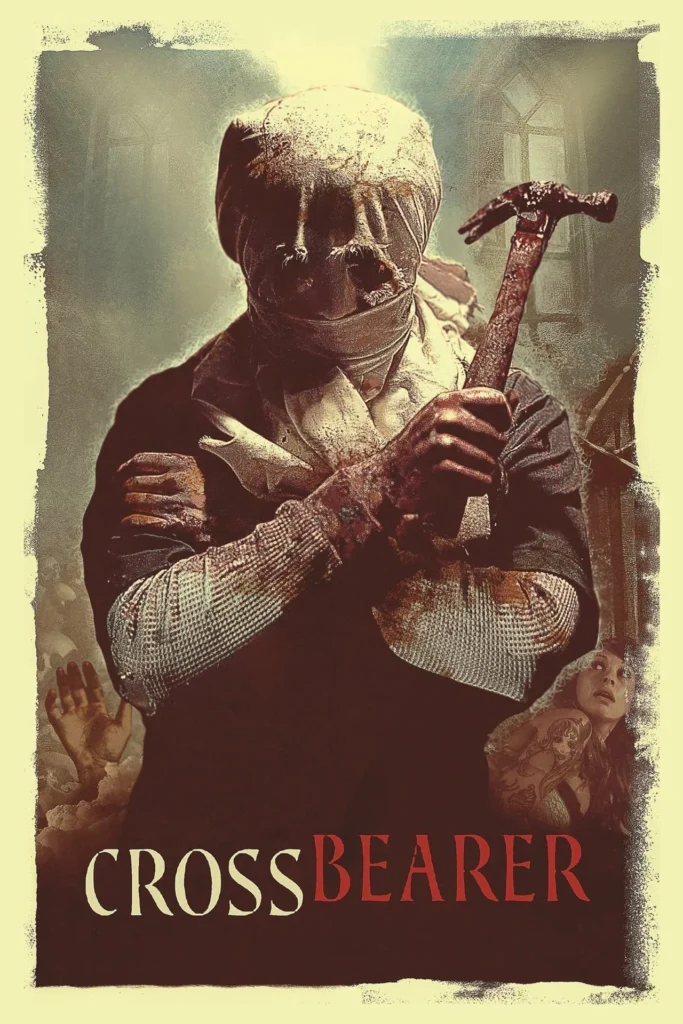
Director: Adam Ahlbrandt
Genre: Horror, Slasher
Runtime: 71 minutes
Language: English
IMDb Rating: Not specified
Plot: A Stripper’s Dream Turns into a Nightmare
Cross Bearer follows Heather (Natalie Jean), a stripper yearning to escape her oppressive life with her girlfriend, Victoria (Victoria DePaul). To fund their getaway, Heather and her lover Bunny (Kacie Marie) plan a drug deal at an abandoned nightclub. Unbeknownst to them, a fanatical killer known as the Cross Bearer (Isaac Williams) lurks within, driven by a twisted sense of divine mission to purge sinners. As the night unfolds, Heather and her companions find themselves in a brutal fight for survival against the relentless murderer.
The film’s gritty atmosphere and grindhouse aesthetic make Cross Bearer a cult-style slasher that doesn’t hold back — every scene pulses with raw tension and blood-soaked chaos. It’s exactly the kind of underground horror that thrives on Gojara, where fans of extreme cinema dig into unapologetically violent, low-budget gems. Beyond the gore, though, Cross Bearer taps into deeper themes of redemption and escape, showing how desperation can blur the line between victim and sinner. For viewers who crave relentless horror wrapped in grim moral undertones, it’s a wild, nerve-shredding ride that sticks long after the credits roll.
Visual Style: Embracing Grit and Grime
Director Adam Ahlbrandt crafts a film steeped in a grimy aesthetic, utilizing desolate locations and dim lighting to evoke a sense of dread and decay. The cinematography captures the seedy underbelly of the characters’ world, with the abandoned nightclub serving as a claustrophobic arena for the ensuing carnage. The film’s commitment to practical effects amplifies its raw and unfiltered atmosphere.
Cast: Portraying the Desperation of the Damned
Natalie Jean (Heather): Delivers a nuanced performance as a woman desperate for a better life, embodying both vulnerability and resilience.
Victoria DePaul (Victoria): Portrays the controlling and drug-addicted partner, adding layers of tension to Heather’s plight.
Kacie Marie (Bunny): Embodies the role of the lover and accomplice, whose aspirations mirror Heather’s own.
Isaac Williams (Cross Bearer): Exudes menace as the hammer-wielding zealot, his presence casting a shadow over the narrative.
The ensemble’s performances contribute to the film’s oppressive and unsettling tone, immersing viewers in a world where desperation meets depravity.
Themes: Sin, Redemption, and the Price of Escape
At its core, Cross Bearer explores themes of sin and redemption, juxtaposing Heather’s quest for freedom against the Cross Bearer’s perverse sense of moral cleansing. The film delves into the consequences of choices made in desperation, highlighting the thin line between victim and sinner in a world devoid of absolution.
Reception: Divisive Responses to Unflinching Brutality
The film has elicited polarized reactions from critics and audiences alike. Rob Rector of INFLUX Magazine acknowledges the film’s shortcomings in acting and production quality but commends its adherence to the grindhouse aesthetic. Matt Boiselle of Dread Central praises the film’s gore and character development, awarding it a 4/5 rating. Conversely, some viewers may find the film’s explicit content and relentless bleakness challenging to endure.
The Critic’s Verdict
Cross Bearer stands as a testament to uncompromising indie horror, delivering a visceral experience that pays homage to the slasher genre’s raw roots. While its graphic content and unrelenting grimness may not appeal to all, the film offers a stark portrayal of desperation and fanaticism that lingers beyond the final frame.
Rating: 6/10
A brutal and unflinching slasher that delves into the darkest corners of human desperation.
Pair With
Maniac (1980) for another exploration of a killer’s psyche, or The Orphan Killer (2011) to continue the journey into relentless slasher territory
Cultural Footprint
By embracing the grindhouse tradition, Cross Bearer contributes to the resurgence of raw and gritty horror cinema, challenging audiences to confront the macabre and the profane.
Addition
Beyond its visceral horror elements, Cross Bearer serves as a commentary on societal decay and the extremes of religious fanaticism. The film juxtaposes Heather’s desperate bid for a better life against the Cross Bearer’s ruthless mission to “cleanse” the world of perceived sinners, highlighting the destructive consequences of radical ideologies. This thematic depth adds a layer of complexity to the narrative, prompting viewers to reflect on the blurred lines between morality and madness.
Moreover, the film’s production faced significant challenges, including harsh shooting conditions during a Philadelphia blizzard, which contributed to the authentic grittiness portrayed on screen. Director Adam Ahlbrandt and his dedicated cast and crew endured these hardships to deliver a film that not only pays homage to grindhouse aesthetics but also stands as a testament to the resilience and passion inherent in independent filmmaking.
